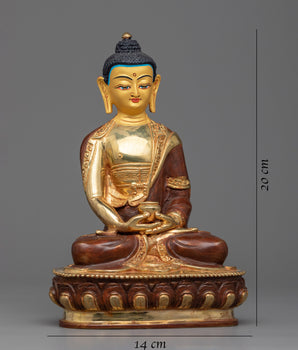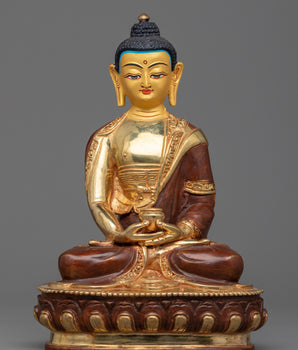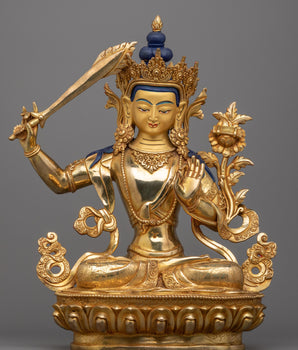












Tibetan Dipankara Statue | Spiritual Symbol of Light

100% AUTHENTIC

HANDMADE

FREE SHIPPING
Handmade Tibetan Dipankara Statue | Buddha of the Past
------------------------------------------------------------------
Size: 8.9”/22.5cm (Height) x 3.9”/10cm (Base)
Weight: 0.93 kg
Material: Oxidized Copper Body
------------------------------------------------------------------
About Our Statue:
The Tibetan Dipankara Statue stands 8.9” (22.5 cm) tall, with a 3.9” (10 cm) base, and weighs 0.93 kg. Crafted from oxidized copper. Dipankara, known as the Buddha of the Past, symbolizes the light of wisdom that precedes Shakyamuni Buddha. Ideal for meditation spaces, personal altars, or sacred collections, this statue embodies enlightenment, continuity, and spiritual awakening.
Dipankara Buddha, also known as the Buddha of Light, is believed to have predicted the arrival of Shakyamuni Buddha, the historical Buddha. This monument depicts his tranquil, enlightened presence, which is deeply connected to prior wisdom and enlightenment. The Dipankara Buddha, whether displayed as a centerpiece in your meditation room or on a Buddhist altar, emits a relaxing, enlightened aura that promotes reflection and spiritual growth.
Dipankara Buddha is a historical Buddha who is revered for foretelling Shakyamuni Buddha's enlightenment. Known as the "Buddha of Lights," he represents knowledge and the lighting of the road to enlightenment. Worshipping Dipankara fosters characteristics like as patience, generosity, and mindfulness, making him a beloved figure in Buddhist practice for individuals seeking spiritual direction.
Introduction To Dipankara Buddha :
Dipankara is a historical Buddha, supposed to have lived on Earth for a hundred thousand years. The number of Buddhas that have existed in theory is tremendous, and they are sometimes referred to as "Thousand Buddhas." Each was responsible for a life cycle. According to certain Buddhist sources, Dipankara (also Dipamkara) was a Buddha who attained enlightenment eons before Gautama. Dipankara is usually shown as a seated Buddha, but standing Buddhas are widespread in China, Thailand, and Nepal; he usually forms a protective mudra (Abhaya mudra) with his right hand, but he sometimes makes it with both hands.
How do you take care of your statues?
• Place them at room temperature, avoiding direct sunlight.
• Make sure that the area where your statue is placed is entirely free of moisture and dust.
• Place it at the highest place on your altar after being consecrated by a Lama/monks. The best practice is to keep them covered inside a glass cabinet.
• Do not use your bare hands or any objects with a rough surface to wipe the face.
• Directly touching objects with the bare hand can smudge the face, leaving scratches.























